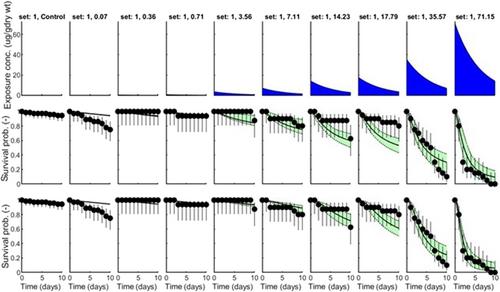下载PDF
{"title":"The Importance of Including Variable Exposure Concentrations When Assessing Toxicity of Sediment-Associated Pharmaceuticals to an Amphipod","authors":"Sara Nicoline Grønlund, Casper D. Læssøe, Nina Cedergreen, Henriette Selck","doi":"10.1002/etc.5894","DOIUrl":null,"url":null,"abstract":"<p>Pharmaceuticals have been classified as an environmental concern due to their increasing consumption globally and potential environmental impact. We examined the toxicity of sediment-associated diclofenac and citalopram administered as both single compounds and in a mixture to the sediment-living amphipod <i>Corophium volutator</i>. This laboratory-based study addressed the following research questions: (1) What is the toxicity of sediment-associated diclofenac and citalopram to <i>C. volutator</i>? (2) Can the mixture effect be described with either of the two mixture models: concentration addition (CA) or independent action (IA)? (3) What is the importance of the choice of (i) exposure measure (start concentration, time-weighted average [TWA], full exposure profile) and (ii) effect model (concentration–response vs. the toxicokinetic–toxicodynamic model general unified threshold model for survival in its reduced form [GUTS-RED]) for the derived effect concentration values? Diclofenac was more toxic than citalopram to <i>C. volutator</i> as a single compound (10-day exposure). Diclofenac exposure to <i>C. volutator</i> provided median lethal concentrations (LC50s) within the same range (11 µg g<sup>−1</sup> dry wt sediment) using concentration–response based on TWA and both GUTS-RED models. However, concentration–response based on measured start concentrations provided an approximately 90% higher LC50 (21.6 ± 2.0 µg g<sup>−1</sup> dry wt sediment). For citalopram, concentration–response parameters were similar regardless of model or concentration used (LC50 85–97 µg g<sup>−1</sup> dry wt sediment), however, GUTS-RED with the assumption of individual tolerance resulted in a lower LC50 (64.9 [55.3–74.8] µg g<sup>−1</sup> dry wt sediment). The mixture of diclofenac and citalopram followed the CA quite closely, whereas the result was synergistic when using the IA prediction. In summary, concentration–response based on TWA and GUTS-RED provided similar and reasonably good fits compared to the data set. The implications are that GUTS-RED will provide a more flexible model, which, in principle, can extend beyond the experimental period and make predictions based on variable exposure profiles (toxicity at different time frames and at different variable exposure scenarios) compared to concentration–response, which provides contaminant toxicity at one point in time. <i>Environ Toxicol Chem</i> 2024;43:1767–1777. © 2024 The Authors. <i>Environmental Toxicology and Chemistry</i> published by Wiley Periodicals LLC on behalf of SETAC.</p>","PeriodicalId":11793,"journal":{"name":"Environmental Toxicology and Chemistry","volume":"43 8","pages":"1767-1777"},"PeriodicalIF":3.6000,"publicationDate":"2024-05-28","publicationTypes":"Journal Article","fieldsOfStudy":null,"isOpenAccess":false,"openAccessPdf":"https://onlinelibrary.wiley.com/doi/epdf/10.1002/etc.5894","citationCount":"0","resultStr":null,"platform":"Semanticscholar","paperid":null,"PeriodicalName":"Environmental Toxicology and Chemistry","FirstCategoryId":"93","ListUrlMain":"https://onlinelibrary.wiley.com/doi/10.1002/etc.5894","RegionNum":4,"RegionCategory":"环境科学与生态学","ArticlePicture":[],"TitleCN":null,"AbstractTextCN":null,"PMCID":null,"EPubDate":"","PubModel":"","JCR":"Q2","JCRName":"ENVIRONMENTAL SCIENCES","Score":null,"Total":0}
引用次数: 0
引用
批量引用
Abstract
Pharmaceuticals have been classified as an environmental concern due to their increasing consumption globally and potential environmental impact. We examined the toxicity of sediment-associated diclofenac and citalopram administered as both single compounds and in a mixture to the sediment-living amphipod Corophium volutator . This laboratory-based study addressed the following research questions: (1) What is the toxicity of sediment-associated diclofenac and citalopram to C. volutator ? (2) Can the mixture effect be described with either of the two mixture models: concentration addition (CA) or independent action (IA)? (3) What is the importance of the choice of (i) exposure measure (start concentration, time-weighted average [TWA], full exposure profile) and (ii) effect model (concentration–response vs. the toxicokinetic–toxicodynamic model general unified threshold model for survival in its reduced form [GUTS-RED]) for the derived effect concentration values? Diclofenac was more toxic than citalopram to C. volutator as a single compound (10-day exposure). Diclofenac exposure to C. volutator provided median lethal concentrations (LC50s) within the same range (11 µg g−1 dry wt sediment) using concentration–response based on TWA and both GUTS-RED models. However, concentration–response based on measured start concentrations provided an approximately 90% higher LC50 (21.6 ± 2.0 µg g−1 dry wt sediment). For citalopram, concentration–response parameters were similar regardless of model or concentration used (LC50 85–97 µg g−1 dry wt sediment), however, GUTS-RED with the assumption of individual tolerance resulted in a lower LC50 (64.9 [55.3–74.8] µg g−1 dry wt sediment). The mixture of diclofenac and citalopram followed the CA quite closely, whereas the result was synergistic when using the IA prediction. In summary, concentration–response based on TWA and GUTS-RED provided similar and reasonably good fits compared to the data set. The implications are that GUTS-RED will provide a more flexible model, which, in principle, can extend beyond the experimental period and make predictions based on variable exposure profiles (toxicity at different time frames and at different variable exposure scenarios) compared to concentration–response, which provides contaminant toxicity at one point in time. Environ Toxicol Chem 2024;43:1767–1777. © 2024 The Authors. Environmental Toxicology and Chemistry published by Wiley Periodicals LLC on behalf of SETAC.
在评估沉积物相关药物对片脚类动物的毒性时纳入不同暴露浓度的重要性
由于药品在全球的消费量不断增加,并可能对环境造成影响,因此已被列为环境问题。我们研究了沉积物中的双氯芬酸和西酞普兰对生活在沉积物中的片脚类动物 Corophium volutator 的毒性。这项基于实验室的研究探讨了以下研究问题:(1)沉积物中的双氯芬酸和西酞普兰对卷尾藻有何毒性?(2) 是否可以用两种混合物模型中的一种来描述混合物效应:浓度添加模型(CA)或独立作用模型(IA)?(3) 选择(i)暴露量(起始浓度、时间加权平均值[TWA]、全暴露剖面)和(ii)效应模型(浓度-反应模型与毒物动力学-毒效学模型一般生存统一阈值模型的简化形式[GUTS-RED])对得出的效应浓度值有什么重要意义?作为单一化合物,双氯芬酸比西酞普兰对伏地龙的毒性更大(暴露 10 天)。使用基于 TWA 和 GUTS-RED 模型的浓度反应,双氯芬酸暴露于 C. volutator 的中位致死浓度 (LC50s) 在相同范围内(11 µg g-1 干重沉积物)。然而,基于测量的起始浓度的浓度响应提供的 LC50 高出约 90% (21.6 ± 2.0 µg g-1 干重沉积物)。对于西酞普兰,无论使用何种模型或浓度,其浓度-反应参数都相似(半数致死浓度为 85-97 µg g-1 干重沉积物),但是,假设个体耐受性的 GUTS-RED 模型得出的半数致死浓度较低(64.9 [55.3-74.8] µg g-1 干重沉积物)。双氯芬酸和西酞普兰的混合物与 CA 非常接近,而使用 IA 预测的结果是协同作用。总之,与数据集相比,基于 TWA 和 GUTS-RED 的浓度反应提供了相似且相当好的拟合。这意味着 GUTS-RED 将提供一个更灵活的模型,与提供污染物在一个时间点的毒性的浓度反应相比,该模型原则上可以延伸到实验期之后,并根据不同的暴露概况(不同时间段和不同暴露情景下的毒性)进行预测。环境毒物化学 2024;00:1-11。© 2024 作者。环境毒理学与化学》由 Wiley Periodicals LLC 代表 SETAC 出版。
本文章由计算机程序翻译,如有差异,请以英文原文为准。


